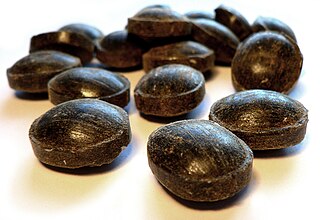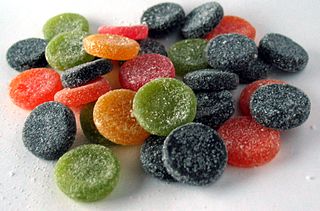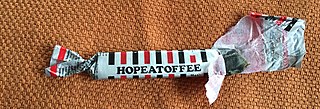
Confectionery is the art of making confections, which are food items that are rich in sugar and carbohydrates. Exact definitions are difficult. In general, however, confectionery is divided into two broad and somewhat overlapping categories: bakers' confections and sugar confections. The occupation of confectioner encompasses the categories of cooking performed by both the French patissier and the confiseur.

Finnish cuisine is notable for generally combining traditional country fare and haute cuisine with contemporary continental-style cooking. Fish and meat play a prominent role in traditional Finnish dishes in some parts of the country, while the dishes elsewhere have traditionally included various vegetables and mushrooms. Evacuees from Karelia contributed to foods in other parts of Finland in the aftermath of the Continuation War.

Liquorice or licorice is the common name of Glycyrrhiza glabra, a flowering plant of the bean family Fabaceae, from the root of which a sweet, aromatic flavouring is extracted.

Glycyrrhizin is the chief sweet-tasting constituent of Glycyrrhiza glabra (liquorice) root. Structurally, it is a saponin used as an emulsifier and gel-forming agent in foodstuffs and cosmetics. Its aglycone is enoxolone.
Drop, DROP, drops or DROPS may refer to:
An excipient is a substance formulated alongside the active ingredient of a medication, included for the purpose of long-term stabilization, bulking up solid formulations that contain potent active ingredients in small amounts, or to confer a therapeutic enhancement on the active ingredient in the final dosage form, such as facilitating drug absorption, reducing viscosity, or enhancing solubility. Excipients can also be useful in the manufacturing process, to aid in the handling of the active substance concerns such as by facilitating powder flowability or non-stick properties, in addition to aiding in vitro stability such as prevention of denaturation or aggregation over the expected shelf life. The selection of appropriate excipients also depends upon the route of administration and the dosage form, as well as the active ingredient and other factors. A comprehensive classification system based on structure-property-application relationships has been proposed for excipients used in parenteral medications.
Koskenkorva Viina is a traditional clear spirit drink (38%) in Finland, produced by Anora Group at the Koskenkorva distillery in Ilmajoki and bottled in Rajamäki, Nurmijärvi.

Tyrkisk peber is a salty liquorice candy flavoured with salmiac, produced by the Finnish company Fazer and popular in Northern Europe. Tyrkisk peber was originally invented by Per Fjelsten in 1976 in Jutland, Denmark and was originally made by the Danish company Perelly, before the company was acquired by Fazer.

Kringle is a Northern European pastry, a variety of pretzel. Pretzels were introduced by Roman Catholic monks in the 13th century in Denmark, and from there they spread throughout Scandinavia and evolved into several kinds of sweet, salty or filled pastries, all in the shape of kringle.

Salty liquorice, salmiak liquorice or salmiac liquorice, is a variety of liquorice flavoured with the ingredient "salmiak salt", and is a common confection found in the Nordic countries, Benelux, and northern Germany. Salmiak salt gives salty liquorice an astringent, salty taste, akin to that of tannins—a characteristic of red wines, which adds bitterness and astringency to the flavour. Consuming salmiak liquorice can stimulate either a savoury or non-savoury palate and response. Anise oil can also be an additional main ingredient in salty liquorice. Extra-salty liquorice is additionally coated with salmiak salt or salmiak powder, or sometimes table salt.

Liquorice or licorice is a confection usually flavoured and coloured black with the extract of the roots of the liquorice plant Glycyrrhiza glabra.

Orkla ASA is a Norwegian conglomerate operating in the Nordic region, Eastern Europe, Asia and the US. At present, Orkla operates in the branded consumer goods, aluminium solutions and financial investment sectors. Orkla ASA is listed on the Oslo Stock Exchange and its head office is in Oslo, Norway. As of 31 December 2021, Orkla had 21,423 employees. The Group's turnover in 2021 totalled NOK 50.4 billion.

Pantteri, sold in Sweden as Katten, is a brand of Finnish salmiakki candy, made by Fazer.
An acquired taste is an appreciation for something unlikely to be enjoyed by a person who has not had substantial exposure to it. It is the opposite of innate taste, which is the appreciation for things that are enjoyable by most persons without prior exposure to them.

Sherbet is a fizzy, sweet powder, usually eaten by dipping a lollipop or liquorice, using a small spoon, or licking it from a finger.

Sisu is a Finnish brand of candy, currently produced by Leaf International.

Marianne is a Finnish mint chocolate candy originally developed in 1949 by Chymos, now produced by Fazer. Marianne candies have a hard peppermint-flavoured shell and a chocolate filling.

Hopeatoffee is a Finnish brand of candy bar, originally launched by Hellas, with a salty liquorice and toffee flavour. Production of Hopeatoffee started in the 1970s, and the candy was a new innovation at the time, as salty liquorice had not been combined with toffee before.

Aakkoset is a Finnish brand of candy sold in Finland since 1970, currently sold by Cloetta under the Malaco brand name. The name "Aakkoset" comes from the various capital letters of the alphabet decorating the lozenge-shaped candies.















